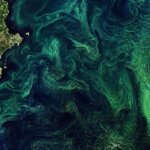With the end of the vacation and vacation period and the entry into a new cycle of increased work, we would like to propose to the readers of “Water Issues” the expansion of the Science section with a new formula. Starting with the current issue, in addition to the author’s existing issue articles, we are introducing a “Literature Review” column. Here you will find suggestions of current, interesting scientific publications on a wide range of water issues. We realize that in an era of galloping publication inflation, the number of articles published each month (even taking into account only the circular ones) reaches several thousand. While each publication contributes some contribution to our knowledge of the world, we assume that only some of them will be of interest to the readers of “Water Issues.” Picking them out of the publishing ocean of knowledge is not an easy task. We hope you will find the works we have proposed worthy of your attention, and perhaps even inspiring for further exploration. Enjoy your reading!
Literature review – summaries of selected articles
1. satellites reveal widespread decline in global lake water storage
Yao F., Livneh B., Rajagopalan B. et al. 2023. Satellites reveal widespread decline in global lake water storage. Science 380, 743-749.
Over the summer, we wrote quite a bit about lakes as a popular vacation destination. Research by an international team of scientists led by Yao from the University of Colorado Boulder, USA, confirms a statistically significant decrease in stored water for 53 percent of of them. It was conducted using satellite imagery, climate data and hydrological models for more than 1,700 of the world’s largest lakes surveyed between 1992 and 2020. The authors attribute the net volume loss in natural lakes to a warming climate, increased evaporation rates and rising human water consumption, and in artificial reservoirs to sedimentation. Researchers estimate that roughly 25 percent of the of the world’s human population reside in catchment areas of lakes affected by desiccation, underscoring the need to integrate the effects of climate change and sedimentation into sustainable water resources management.
2. the recovery of European freshwater biodiversity has come to a halt
Haase P., Bowler D.E., Baker N.J. et al. 2023. The recovery of European freshwater biodiversity has come to a halt. Nature 620, 582-588.
Water resources are all the more at risk because it appears that efforts over the past 50 years to improve the quality of the water environment have ceased to yield satisfactory results. This was demonstrated by an international team of dozens of scientists from Europe and the United States, who analyzed nearly 2,000. time series on freshwater invertebrate communities collected in 22 European countries between 1968 and 2020. The increase in biodiversity as a result of remediation efforts was mainly observed in the 1990s. and early 2000s. Unfortunately, this trend reversed after 2010, suggesting that the measures currently being implemented are having unsatisfactory results.
3. species redistribution creates unequal outcomes for multispecies fisheries under projected climate change
Liu O.R., Ward E.J., Anderson S.C. et al. 2023. Species redistribution creates unequal outcomes for multispecies fisheries under projected climate change. Sci. Adv. 9, eadg5468.
Climate change, in addition to many other natural and socioeconomic effects, also modifies the distribution of species, thereby affecting the availability of resources for human use. The problem was looked at by a team of American scientists who analyzed projected changes in the distribution of economic fish species along the west coast of the United States over the next half century. Species-specific forecasts indicate that in response to warming and reduced oxygen concentrations, the availability of the most economically valuable target fish is likely to decline throughout the study area, forcing fishermen to adapt by changing where and what they fish.
4. global methane emissions from rivers and streams
Rocher-Ros G., Stanley E.H., Loken L.C. et al. 2023. Global methane emissions from rivers and streams. Nature.
Methane (CH4) is a potent greenhouse gas whose increasing emissions are contributing to climate change. There is evidence that global warming has increased CH4 emissions from freshwater ecosystems, providing an additional feedback loop for climate change. Lakes and wetlands have been accepted as the main source of methane, but it turns out that the role of watercourses is not at all marginal. An analysis by an international team of scientists led by Rocher-Ros of Umeå University in Sweden, based on tens of thousands of data from the Global River Methane database, indicates that global estimates of CH4 emissions from running waters average 27.9 Tg per year, roughly equal to emissions from other freshwater ecosystems. Global patterns of methane emissions are explained by edaphic and climatic factors that determine the occurrence of anoxia in and near riverine habitats, including a large supply of organic matter and water saturation of soils.
5. Eutrophication and derivative concepts. Origins, compatibility and unresolved issues
Kornijów R. 2023. Eutrophication and derivative concepts. Origins, compatibility and unresolved issues. Ecohydrology & Hydrobiology.
6 Lake aging concept revisited: an alternative comprehensive approach to lake ontogeny
Kornijów R. 2023. Lake aging concept revisited: an alternative comprehensive approach to lake ontogeny. Can. J. Fish. Aquat. Sci. 00: 1-9.
Limnologists and other admirers of still waters will certainly be intrigued by the work on revising the issue of water eutrophication. An article by Prof. Korniyov, “Eutrophication and derivative concepts,” appeared in the journal Ecohydrology & Hydrobiology a few weeks ago. Origins, compatibility and unresolved issues,” in which the author attempts to substantiate the concept of aging lakes (ang.. lake aging concept, LAC), which assumes an inevitable increase in trophic status during lake development and wrongly equates eutrophication with the progressive disappearance of lakes on a geologically relevant time scale. The author also presents the assumptions of alternative stable state theory and the discrepancies between the concepts discussed in terms of using different terminology for the same phenomena and lake classifications. The article is, in a way, a continuation of a previous publication by this author titled, “The Future of the World. “Lake aging concept revisited: an alternative comprehensive approach to lake ontogeny,” which appeared a month earlier in the Canadian Journal of Fisheries and Aquatic Sciences. The purpose of this text was to verify the validity of the assumptions of the concept of aging/maturation of lakes, and to present a synthesis of knowledge from various fields of environmental science on the development of glacial lakes in the context of climate change, as well as changes in reservoirs and their terrestrial surroundings over the past 10,000 years. years.

 Polski
Polski






